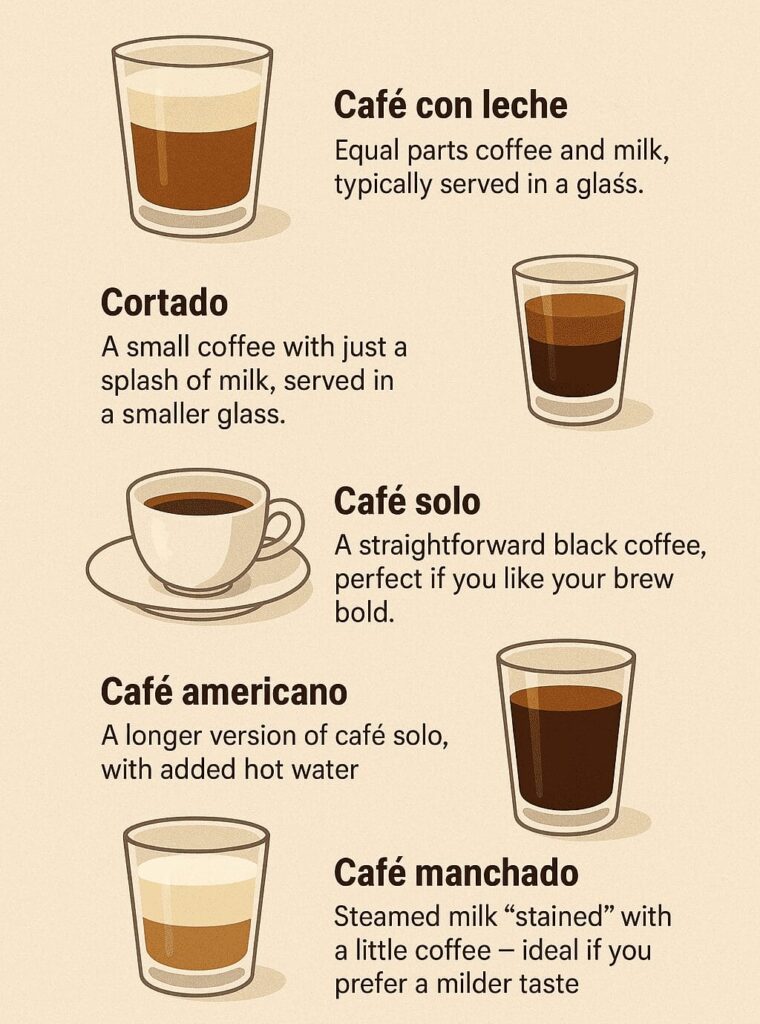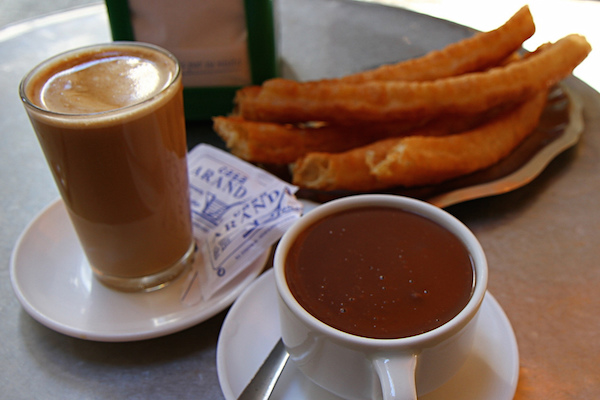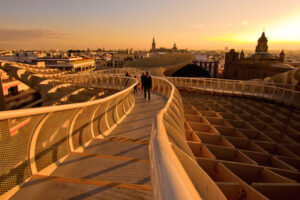Last Updated on December 24, 2025 by Emma Fajcz | Published: July 6, 2015
You probably already knew that Spain has a big wine and beer culture, but we also have a big coffee culture too! If you are planning to enjoy coffee in Seville, whether you’re after a quick café solo at the bar or a leisurely sit-down at a local café, this guide covers it all—from ordering tips, pronunciation to the best Cafes in Seville.

Types of Coffee You’ll Find in Seville
Seville offers a delightful variety of coffee options that reflect both tradition and modern tastes. Here’s a quick look at some favorites:
- Café con leche: Equal parts coffee and milk, typically served in a glass.
- Cortado: A small coffee with just a splash of milk, served in a smaller glass.
- Café solo: A straightforward black coffee, perfect if you like your brew bold.
- Café americano: A longer version of café solo, with added hot water.
- Café manchado: Steamed milk “stained” with a little coffee – ideal if you prefer a milder taste.
How Milk Changes Your Coffee Order
Milk isn’t just an add-on in Seville; it transforms the experience. For instance, locals insist on having a café con leche served in a glass. If it comes in a mug, you might even see a polite correction from the waiter. The texture and temperature of the milk are key, and knowing your options can really upgrade your coffee moment.
Best Places to Order Coffee in Seville
Not all cafés are created equal. Here are a few local favorites that offer a mix of tradition and modern, third-wave vibes:
- La Cacharrería – A cozy spot with a unique charm.
- Virgin Coffee – Known for its excellent brew and trendy atmosphere.
- El Pintón – A blend of classic service with a modern twist.
Expert Tip: Take a look at our blog on Unique Cafe’s in Seville, to discover lots of hidden gems!
How to Order Coffee Like a Local
Ever wondered what the secret is to blending in at a Sevillano café? Here’s a simple, step-by-step guide:
Step 1: Approach the bar and greet the staff with a friendly “¡Buenos días!”
Step 2: Specify your choice clearly – for example, “un café solo” or “un cortado”.
Step 3: If you prefer milk, ask for a café con leche and note if you like it lighter (manchado) or balanced.
Step 4: Don’t forget to grab a sachet of sugar – it’s almost always on hand, and a little sweetness goes a long way.
This approach ensures you get your coffee just the way you like it, while embracing local customs.
When you go out for breakfast regularly in Seville, you’ll start to build a special rapport with the people who work at your go-to café.
Coffee Culture in Seville: When and How Locals Drink It
Drinking coffee is a tradition which is engrained into every day life in Seville. It begins in the morning with a coffee to get the day started, it continues throughout the day as a way to take a break or meet with friends, and it moves on into the evening as something to enjoy at the end of the meal while partaking in lengthy post meal discussions with friends and family.
Aside from a coffee first thing in the morning, and enjoying a coffee after a meal, sevillanos have two “official” coffee breaks in their day.
The first is in the mid-morning, around 10am to 11am. At this time many locals take a break from work to have their breakfast. Breakfast upon rising in Seville is light, or for some non existent, so this is when many locals will stop to eat properly, as well as having a coffee alongside it.
The next is la merienda, the afternoon snack, which is taken anywhere between 5pm to 8pm and usually involves something sweet, as well as a coffee to keep the energy levels high. Take a look at the best pastry shops in Seville for your next Merienda!

But what type of coffee do you actually order in Seville?
Let’s start with the favorite among locals, and most likely visitors too – a simple coffee with milk. In Seville, a cafe con leche is almost always served in a glass. More times than we can count, we have witnessed locals sending back their coffee because it was served in a mug, or waiters apologizing profusely for coffees served in mugs due to lack of glasses, so don’t be surprised when your cafe con leche turns up in a glass.
Although a cafe con leche is the most common coffee with milk, is it strong. The proportions are not what you would typically imagine for a milk coffee. Usually in a cafe con leche, the serving is 50% milk and 50% coffee.
Next up there is the cortado. A cortado is a coffee served with just a splash of milk. The amount of coffee served is similar to that in a cafe con leche, and the cortado will also be served in a glass, albeit a smaller one than the cafe con leche.

If you prefer black coffee, ordering a cafe solo usually does the trick. This is just a serve of coffee, the same amount as the cafe con leche and cortado, but without the milk. It is larger than an Italian espresso, but if you prefer your black coffee even larger again, you can make it long by ordering a cafe americano, in which case the coffee will be served in a longer glass with hot water added.
If this all sounds too much and you were hoping for a weaker milk coffee, similar to a cafe latte back home, in Seville we have just the solution. It’s the cafe manchado, which literally means “stained milk”. This coffee is a glass of steamed milk with just a small serve of coffee in the bottom of the glass.
In all cases, your coffee will usually be served with sachets of sugar and you will be expected to use it. Even if you don’t usually take sugar in your coffee, you may find yourself giving up and ripping open the sachet after just one sip. Sugar is standard in Seville, quite simply because locally roasted coffee in Spain is bitter.
How to Pronounce Spanish Coffee Terms
Getting the pronunciation right not only shows respect but also helps in placing your order confidently. Here are a few tips:
- Café solo: Say “kah-FEH SOH-lo”.
- Café con leche: Pronounce it as “kah-FEH con LEH-cheh”.
- Cortado: It’s “kor-TAH-doh” with the emphasis on the second syllable.
- Café manchado: Emphasize “man-CHA-do” to highlight the “stained milk” charm.
Want to hear more? Check out this video from our expert Devour guide, Luke on how to order coffee like a true local
Coffee in Seville: FAQ
What kind of coffee do people drink in Seville?
Sevillanos enjoy classics like café solo, cortado, café con leche, and the lighter café manchado.
Where can I find the best coffee in Seville?
Great local cafés such as La Cacharrería, Virgin Coffee, and El Pintón offer a mix of traditional charm and modern, third-wave vibes.
How do I ask for decaf in Seville?
Simply ask for descafeinado. You might also specify de máquina (machine-made) or de sobre (instant) if needed.
Is tipping expected when I get coffee in Seville?
While tipping isn’t required, rounding up or leaving small change is always appreciated.
What’s the difference between a cortado and a café con leche?
A cortado is a small coffee with just a splash of milk, while a café con leche offers a balanced mix with equal parts milk and coffee.
Do most cafés in Seville offer take-away?
Some modern coffee shops do offer take-away, but traditionally locals drink coffee standing at the bar or seated at a table.
Are there vegan or plant-based milk options in Seville cafés?
Trendy cafés may provide oat or soy milk options, but most traditional bars stick to standard milk. It’s best to ask first.









But unfortunately it is difficult to find speciality milks for coffee such as Almond, Oat and Soya. They need lessons from Australian Barristas in how to present an attractive swirl in the cup